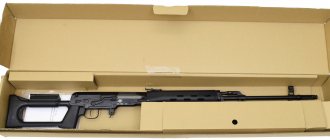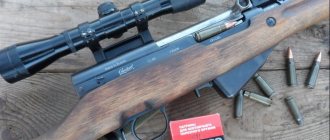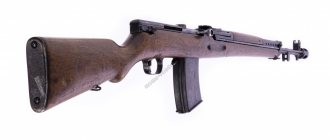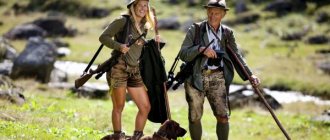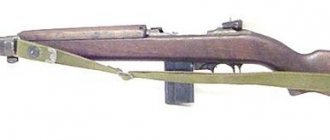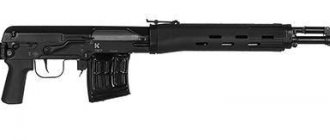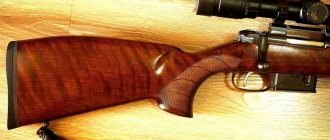Lightweight and shortened rifles are called carbines. In addition, its name is also used in the army, among athletes and hunters. The main requirements for carbines are compactness, low weight and high combat properties. The SKS carbine of 7.62 mm caliber was the most famous brand in Russia; reviews of hunters and owners about the carbine can be found online on various web resources. In this review we will tell you what role the SKS carbine played in the history of Soviet-era weapons, its technical parameters and design.
How the SKS carbine was created
This weapon was created together with the Kalashnikov assault rifle for a special type of 7.62 cartridge from 1943. The base was the previous model AKS-22, developed at the beginning of World War II. During this period there was a great need for a new type of weapon. At that time, the main model of the rifle was the famous “Mosin-Nagan” produced in 1898. Self-loading rifles AVS and SVT were used in small quantities. However, their peculiarity was that they were not suitable for soldiers and army command staff. For example, they needed serious care, and during battle this was often impossible.
The Mosin rifle was considered an unpretentious and reliable design, but also did not satisfy many requirements. In such poor conditions, commanders needed a reliable, unpretentious weapon capable of fighting over a long distance, compared to the PPS or the Shpagin submachine gun, while the magazine capacity needed more than five rounds, compared to the Mosin rifle. Therefore, the SKS carbine was developed and created, the technical parameters of which were in many ways better than the Kalashnikov assault rifle.
If you hunt big game with SKS...
For a number of well-known reasons, many hunters have to shoot not from the weapons that are recommended in serious literature, but from the ones that he can purchase, especially in areas remote from civilized centers.
In particular, in the area where I live and where hunting large animals - bears, elk - is very common, hunters are mainly armed with the SKS carbine, as you know, for a large animal it is not the most powerful. But it is from this carbine with the 7.62x39 cartridge that the bulk of bear, elk and reindeer are shot. Therefore, I think it would be interesting to talk about some results of firing from SKS carbines with the 7.62x39 cartridge and KO-44 carbines with the 7.62x53 cartridge.
The 7.62x39 cartridge with a jacketed bullet has high penetration ability, but low stopping power for large animals. And when shooting, this must be taken into account. When shooting, inexperienced hunters exaggerate the capabilities of this carbine and expect to kill the animal with the first shot, especially when shooting locally. But this does not happen often, especially when shooting a large animal. Often a wounded animal leaves - and then the usual story with wounded animals follows, with all the moral and material consequences.
Let me give you an example. At the end of the 1993/94 winter season in mid-January, early in the morning, near the hut, the huskies raised the animal. The barking was “persistent”, and my partner and I, without hesitation, went to the dogs.
At the edge of the forest, an elk stood in the sparse larches. Deep snow made it difficult for the dogs to work. Usually in such conditions the elk would leave, but here he let us get quite close. And from a distance of 80-90 m I fired from the KO-44 carbine. But, to our surprise, the elk did not fall, but began to move closer to the forest along with the huskies dancing in front of its face. The next two shots also did not produce results. But after about five hundred meters the dogs stopped the elk again, which, again, was unusual. (In our northern regions, the elk is far from the same as in the west. Usually, after an unsuccessful shot, not paying attention to the dogs, he goes far away and behaves strictly). And only after the fifth shot the elk fell.
Upon examination, the moose's behavior was not entirely normal. The very large bull, which had already shed its antlers, had previously been wounded by a bullet from an SKS. The bullet went right through the ribs. In the event of a similar hit by a bullet of a different caliber, or even by a bullet from a KO-44 carbine with a more powerful cartridge, the elk would remain in place. And when wounded by a bullet from an SKS, he remained on the move, although he was doomed - his right side was a complete abscess, and the elk was in a severe stage of exhaustion. But despite all this, he found strength and tried to get away from the huskies.
The reason for the misses was also revealed. It turned out that the clamping screw on the carbine's fore-end had come loose, which led to the scattering of bullets. Having tightened the screw, I checked the battle with test firing - it returned to normal.
This suggests that we need to be more careful about checking the condition of the weapon. In another case, for example, if there were a wounded bear in the place of the elk, such “shooting” would be costly.
And so, in order to prevent such cases, not to let wounded animals go, experienced hunters, using the SKS rate of fire, regardless of the results of the first shot, fire several shots at the animal. In this case, the destructive effect of not one, but two, three and, often, more bullets is used. In this case, the elk or bear, regardless of weight, lies down on the spot. Especially if a regular jacketed bullet passes through bones.
The result of such shooting can be compared with a buckshot shot: when hit by one or two buckshots, the animal leaves, and when hit by four or five, it goes down. The same thing happens when firing from an SKS. It is not difficult for an experienced hunter to make several aimed (control) shots, since the aiming line is maintained during shooting.
But this cannot be said about the KO-44 carbine, where loading is done manually, although the 7.62x53 cartridge, due to its stopping effect, allows you to confidently shoot large moose and bears.
Due to the above, the majority of hunters in our area, including regular ones, prefer the SKS carbine. This is explained, as I said above, by the impossibility of acquiring a weapon suitable for hunting large animals, but we must not forget that what attracts people to the SKS carbine is its relative cheapness, reliability, ease of use, trouble-free operation, which in the conditions of the Far North are not the least quality.
V. SERGIENKO
gun.ru
Tag: Hunting_Useful_tips Discuss the article on the forum
Who developed the SKS carbine
All the work to create this legendary weapon was carried out by designer Simonov. This is a famous gunsmith who developed weapons such as PTRS, PPS, ABC. He also collaborated with such designers as Degtyarev, Fedorov, and learned shooting from them. Until that time, Simonov worked at a machine gun factory in Kovrov, then began to pursue a career and entered the Academy of Industry. Subsequently, he developed the Simonov rifle - ABC-36, which was adopted into the army instead of the Fedorov assault rifle.
As a result of a lot of work, engineer Simonov developed a new model of a carbine and presented it to the government of the country. It was 1949. At the same time, the Kalashnikov assault rifle was released. The SKS carbine was approved for service with the army. For his work, Simonov was awarded the title of Hero of Labor. He was also awarded various orders, prizes and awards.
At first, the carbine used a needle-shaped bayonet. It was then replaced by a knife-shaped bayonet with a folding mechanism. During the production of weapons, adjustments and modernization of the carbine device took place. Production began in 1943, but due to many changes in the design, the carbine was released only in 1949.
SKS-45: a carbine with an unfortunate fate
Photo by Vsevolod SEDOV
There are weapons that become legendary. One is deserved as the pinnacle of perfection (Mauser Gewehr 98) in its class; another, as the height of reliability, unsurpassed to this day (AK-47), the third - at the will of the country's leadership (Russian three-line). And there are weapons that are unlucky. One was prevented by political events and the short-sightedness of the country's leadership (Fedorov's assault rifle); the other was too innovative for its time, people were not ready (SVT-40). An unfortunate fate awaited the SKS-45.
Let's start with history. For reliable operation of automatic personal small arms, rifle cartridges, which were in service with armies at the beginning of the 20th century, were too powerful. Already V.G. Fedorov created a special cartridge for his machine gun with a lower recoil impulse than the standard 7.62X54R cartridge. The Second World War showed that automatic weapons are extremely necessary for every infantryman, but a powerful rifle cartridge did not allow the creation of mass-produced inexpensive, compact and lightweight automatic weapons. Only we (SVT-40) and the Americans (M1 Garand) succeeded. At the same time, submachine guns chambered for a pistol cartridge had a short firing range (up to 200 m) and had low penetrating power. What was needed was a cartridge less powerful than a rifle, but more powerful than a pistol. This is how the class of intermediate cartridges appeared.
The Germans entered the war with only the 98k carbine. The bulk of the soldiers were armed with these weapons. Both the MP-38 and MP-40 submachine guns were in service with the crews of armored vehicles, paratroopers and auxiliary troops. There were few of them in combat units. That is why the PPD-40 and PPSh-41 found their fans in the Wehrmacht combat units. But already in 1943, the Wehrmacht adopted the StG 44 assault rifle chambered for 7.92X33.
The USSR also kept up with global trends, but the advent of assault rifles chambered for an intermediate cartridge among the enemy spurred work in this direction. Already in 1943, the 7.62X39 cartridge designed by N.M. was adopted for service. Elizarova and B.V. Semina. Since there is a cartridge, then a weapon is needed for it. And the first, by the end of 1944, was Sergei Gavrilovich Simonov who offered his weapon. The weapon developed by Sergei Gavrilovich was already accepted and was in service with the army. It was an ABC-36 rifle and a PTRS anti-tank rifle, which, oddly enough, is still used to this day in Ukraine. Sergei Gavrilovich was an experienced gunsmith who had a large backlog of samples, one of which served as the prototype for the SKS-45. Allegedly, the first samples of the SKS-45 underwent military tests on the 1st Belorussian Front at the beginning of 1945 and received positive reviews. Development of the carbine and cartridge continued until 1949, when the SKS-45 was adopted by the Soviet Army. A legitimate question arises: why adopt a model whose performance characteristics are obviously worse than that of the model just adopted? After all, it is this year that the AK-47 is being adopted. It seems to me that one of the reasons was the price of weapons. The fact is that the first AK-47 had a milled receiver, which was very expensive, and arming the entire army with such expensive models would have been very expensive. In addition, due to the fact that weapons chambered for an intermediate cartridge were a new product, the role of each weapon in the weapon system was not entirely clear. Initially, the idea was to arm the motorized infantry squad with both AK-47 and SKS-45. These samples had both advantages and disadvantages. The SKS-45 had a larger target firing range (1000 m versus 800 for the AK), a longer barrel, and therefore better accuracy of fire. The weight of three SKS-45 clips was much less than one AK magazine (330 g), and the size of three loaded clips was smaller than an AK magazine with 30 rounds, which made it possible to increase the carryable ammunition. Also, the SKS-45 was lighter and more versatile than the AK-47. At the same time, the AK was shorter than the SKS and, at a tense moment in the battle, due to automatic firing, it made it possible to increase the density of fire of the unit at a short distance.
Everything was decided in 1959, when the AKM was adopted. Its production used 80% less metal than the AK-47, the firing range increased to 1000 meters and other design changes were made. AKM has become cheaper and lighter. The need for the SKS-45 disappeared, but until the end of the 80s it was in service with the SA in auxiliary units in the interior of the country, air defense forces, etc. To this day, the SKS-45 is in service as a ceremonial weapon.
The SKS-45 was in service with China, Bulgaria, the DPRK and others. It was produced with changes in the GDR and Yugoslavia. In Vietnam, it took part in the war with the United States and proved itself to be a simple, reliable, trouble-free and accurate weapon.
If the SKS had appeared a couple of years earlier, it would have been a legendary weapon, like, for example, the PPS-43. But he had no luck in his military career. But his civilian career, which at first was quite successful, also did not lead him to the pinnacle of success.
In the SA, the AKM has triumphed, the SKS is banished to warehouses, exiled to Egypt and Vietnam, vegetates in the rear air defense units, and at this time, hunting farms have an urgent need for rifled automatic weapons for commercial hunting and land protection. And SKS went into civilian life.
Fishermen and huntsmen in the USSR appreciated the lightweight, reliable, compact, accurate carbine, the cartridges for which could be obtained in the neighboring unit. The SKS-45 remained a hunter's dream until the early 90s, when ordinary hunters were allowed to buy rifled weapons. And the SKS-45 turned out to be the cheapest and most accessible model. And then it turned out that the 7.62X39 cartridge is too weak for hunting big game! How so?! After all, hunters and rangers with the SKS also went after bears. And everything was fine, the cartridge had enough energy, and then suddenly the cartridge weakened! And the casket simply opened. The overwhelming majority of hunters and huntsmen were excellent shooters and knew WHERE to shoot in order to kill an animal with one shot. And the new owners of the SKS shot poorly, and knew the anatomy of animals even worse. And they began to breed wounded animals. This is where the rumor about the weak 7.62X39 cartridge came from. And the bans began. The popularity of SKS among hunters has fallen, they began to be handed over to the licensed for destruction. Now it’s quite possible to find SCS on the Internet for about five thousand. In my presence, a former Airborne Colonel handed over a practically new SKS for destruction and was ready to give it to anyone, but there were no takers. So in civilian life the Escaes were unlucky. But everything could have been different.
The SKS itself could well serve as the basis for a hunting weapon, for example, chambered for the 5.6X39 cartridge. Allegedly there were several experimental carbines chambered for this cartridge. It's possible. After all, to adapt the SKS to the 5.6X39 cartridge, you only need to replace the barrel or install it in the barrel of a liner. Is there a need for such a carbine? Yes, such a carbine will find its admirers among hunters of foxes, wolves, roe deer and others. Also, as I see it, the SKS locking unit is quite capable of withstanding the energy of the .308 Win cartridge. After this, all talk about the “weakness” of the SCS would disappear. And the SKS-308 could be the cheapest automatic hunting carbine. No, it cannot be said that the manufacturer has completely forgotten such an outstanding freebie as the SKS. Not long ago, the VPO-208 carbine chambered for the .366 TKM cartridge appeared. The peculiarity of this new product is that it is a smoothbore gun with a rifled part at the end and is sold as a smoothbore weapon. The barrel used is original, from the SKS, only bored to 9.2 mm, and at the end - rifling. Personally, I think that the idea of rifling at the beginning of the barrel is better: under the influence of powder gases, the bullet slowly crashes into the rifling, gradually accelerating. After passing through the rifled part, the speed increases in a smooth barrel. And if the rifling is at the end of a smooth barrel, then the bullet, which has almost maximum speed, flies into the rifling and, braking, begins to twist. Imagine and think which option is better. But, apparently, AKBS patented such a solution or did something else, because it was not used anywhere except for Muflon-410, which is no longer on sale. Well, yes, these are technical subtleties. But what’s not very good about VPO-208 is the price. In stores it can be found at prices ranging from 28 to 37 thousand rubles. I think it's a bit expensive! Escaes is unlucky again.
But let's hope that fate will turn its face to the SKS and it will be as popular here as in the shooting States of America, where citizens have more than three million SKS in their hands! Moreover, in the USA a bunch of gadgets for SKS are produced, ranging from front sights to butts. A lot of them are also produced here. So it's not all bad. Perhaps the fate of the SKS-45 in its homeland will be more successful.
Igor Suslov September 26, 2016 at 00:00
The SKS carbine is a weapon of many countries
Simonov's weapons took part in various armed conflicts after World War II. The carbine was used by Viet Cong guerrillas during the Vietnam War, as well as in North Korea, Laos, Africa, and Cuba. This wide distribution is explained by the increased combat qualities of the carbine, as well as mass production in different countries under license from the Soviet Union.
In China, the carbine was called “Type 56” for some time, and was equipped with a device for installing an optical sight. The carbine also had a modified magazine with a capacity of 30 rounds, similar to the Kalashnikov assault rifle. The SKS carbine was produced in Albania, Egypt, Yugoslavia, and Germany. Even today, in many countries such weapons are in service with the army.
SKS: immortal weapon
The National Interest devoted an article to Simonov's self-loading carbine, which continues to be a popular weapon despite its advanced age
The weapon symbol of the 20th century is undoubtedly the AK47. The iconic rifle of World War II is the Mosin Rifle. Both weapons were developed in Russia. With Simonov’s self-loading carbine, everything is more complicated.
Its design appears to be a cross between a Mosin rifle and an AK47. The SKS has a simple integral 10-round magazine, a significant improvement over 19th century designs.
Classic Soviet SKS
The SKS uses the same 7.62mm cartridge as the AK47. But the machine’s removable 30-round magazine made it significantly more powerful, which is exactly what the Soviet army needed in the post-war years. As a result, the SCS was used to a very limited extent, mainly for ceremonial purposes. And also among border and reserve units.
But the SKS was an adaptable, reliable and powerful weapon. So much so that it is still used in 21st century wars.
American journalist Christopher Chivers, in his historical book “The Gun,” described how the Chinese delegation in the post-war years was furious when they saw the production of SKS in the Soviet Union. After all, the USSR supplied China mostly with Mosin rifles.
Whether this is true or not is unknown. But China eventually obtained the technology they were interested in and created millions of clones of the Simonov carbine called Type 56. Although after failure in the Sino-Vietnamese War of 1979, engineers in the Middle Kingdom were forced to admit that this design was significantly outdated. Then Type 81 appeared: a hybrid of AK and SKS.
Chinese war posters
The situation was different in the 50s and 60s: at that time, the carbine suited Chinese Maoist military doctrine, which prioritized basic rifles, sniper attacks and ambushes. The SCS has a limited ammunition capacity of 10 rounds, which was not a major problem—Maoist fighters bolstering mainland China's defenses had to travel light.
For the same reasons, the Simonov carbine remains in the arsenal of rebels and partisans around the world to this day. It is even used in Syria and Iraq, although they are now less common.
Copies of the carbine made in Yugoslavia (Zastava M59/66) are also quite common, although this version has some disadvantages. The Yugoslav SKS does not have a chrome-plated barrel: this reduces the reliability of the weapon. But this version has a 22mm barrel grenade launcher.
Yugoslav copy of SKS
This is a bonus for all sorts of rebel armies, but for most shooters the grenade launcher makes a simple weapon look heavier. In addition, this option is more prone to misfires, since the Yugoslav SKS uses a different design for connecting the gas chamber to the barrel.
The SKS occupies an unusual place among gun collectors. Because China produced and exported so many copies of the carbine, the SKS became a cheap and popular hunting and sporting weapon in the West.
Since the SKS is limited to 10 rounds, factory versions are easier to obtain in states and countries that restrict the circulation of rifles with larger capacity magazines.
The United States also imposed restrictions on imports from Chinese manufacturer Norinco in 1993. This makes the SKS a rare example of a weapon that is easier to acquire in Canada, where such restrictions have not been imposed.
For collectors, the carbine has added historical and military value, with Soviet versions being among the most coveted given their limited production.
It's hard to say that Simonov was ahead of his time. The carbine was a Soviet competitor to the German Gewehr 42 and the American M1 Garand, but was more reliable than the Gewehr and much easier and cheaper to produce than the Garand.
He's not perfect. For example, if you do not clean the firing pin, the Simonov carbine may start firing randomly, and this is very dangerous.
But few will deny that the SKS, despite its advanced age, continues to serve. It is unlikely that its creator, Sergei Simonov, who died in May 1986 at the age of 91, could have predicted such a long history of his brainchild.
Original - The National Interest
Author - Robert Bekusen
Weapon characteristics
The SKS carbine has the following technical parameters:
- The weight of the weapon when unloaded is 3.75 kg.
- The weight of the carbine with a full magazine is 3.9 kg.
- The rate of fire of the carbine is 40 rounds per minute.
- Sighting range – 1 km.
- Magazine capacity – 10 rounds.
- Caliber – 7.62 mm.
The gas mechanism is designed in such a way that only single shots can be fired. To learn how to use the SKS carbine, you do not need a lot of time and knowledge. It has good grip, balance and is properly balanced. The carbine barrel is longer than the Kalashnikov assault rifle. This makes it possible to achieve good combat accuracy. When shooting at a distance of 800 meters, the spread is in the range of 29-38 mm.
Video review of the SKS-SKH cold rifle (Simonov carbine):
Promotion in honor of the holidays, with the purchase of a cold SKS SHP and 200 rounds of ammunition, another 200 rounds of ammunition as a gift . (The price for this promotion in total for 400 rounds of ammunition is 9,000 rubles, i.e. 22.5 rubles per piece)
This is a self-loading carbine of the Simonov system; it fires blank cartridges of 7.62*39 caliber (Exactly the same cartridges are suitable for a blank AKM).
The SKS-SX is based on the Simonov combat self-loading carbine, the magazine of which can hold up to 10 rounds .
The cooled SKS-SX carbine weighs only 3.5 kg, with a length of 850 mm, it is quite accurate and mobile, and most importantly, it is sold without a license
.
The stock, gas chamber lining and carbine butt are made of natural wood. For safety, all wooden parts of the SKS are varnished.
All mechanisms of the Simonov rifle are made of weapons-grade steel; to extend service life, the metal outer parts of the rifle are blued.
The carbine uses a magazine with a clip, i.e. The cartridges are held motionless on some kind of guide.
The combat equivalent entered service in 1949 and remained in service for about ten years. Although Simonov's carbine did not have the ability to fire automatically, it was distinguished by higher shooting accuracy at long distances (its barrel was almost 11 cm longer than that of an AK assault rifle).
The online store Popadiv10.RU recommends Simonov's self-loading, cold-bodied carbine for use in various theatrical scenes or historical films in which it is necessary to shoot. During a shot, smoke and fire come out of the SKS-SX barrel, since the barrel is blocked by pins for only 30-40% of the total cross-section of the barrel.
The shot deserves special attention; it is much louder than a shot even from a Kalashnikov assault rifle, so the rifle can be used to scare away wild animals or angry dogs. If necessary, SKS-SX can be used for defense against intruders. A loud shot into the sky with a falling cartridge case will put any bandit in a stupor and force him to retreat.
The design and principle of operation of the carabiner
The automatic weapon is triggered by the action of powder gases through the barrel channel. Using the bolt, the barrel bore is locked. The bolt stem moves under the action of a piston and a pusher with a rod on a spring. These parts are not involved in subsequent work, which guarantees smooth operation of the automatic system. As the stem moves back, the rear of the bolt rises and moves away from the receiver. The barrel bore is locked when the bolt rolls in. The return device is located in the gate stem in a special channel. The stem also acts as a charging handle.
Hammer-type impact device with a coil spring. It is made on the basis of the trigger guard and forms a single device. The safety is made in the form of a flag and is located behind the trigger. To prevent a shot from happening when the barrel is open, an automatic trigger is used.
The carbine is equipped with a magazine that holds 10 rounds, the design is non-removable. The bolt is equipped with grooves for the clip to make it convenient to equip the magazine. The sector sight is open and marked up to 1000 meters. There is a front sight near the muzzle. The aiming block is located in the center of the weapon. The carbine is equipped with a wooden stock with a pistol grip for the palm. The barrel cover is not removable and is firmly attached to the gas outlet tube.
Worldwide popularity and use after the war
After the weapon became obsolete, it began to be used as a service weapon in various troops. In Ukraine, the carbine is still used in security services and honor guards in various troops. Today the carbine is also widely used by hunters. It has become the most cost-effective weapon and is worth the money spent on it. Hunting with such a weapon is always successful and convenient.
The SKS carbine became widespread in the USA. America acquires such carbines of different production dates. Today, about 1.5 million of these carbines are available in America. Their designers are enthusiasts of their craft, so they create different versions of weapons. For example, some companies have developed a high-capacity magazine for it, which can already hold 30 rounds, and also equip it with optical sights.
Some parts of the carabiner are modified to resist rust. Plastic linings with a pistol grip, a movable butt, and a device for mounting a bipod are also created.
SKS carbine on the hunt
The weapon has good shooting performance. Of course, old ammunition is not entirely suitable for hunting, but it plays an important role among professionals and amateurs in hunting. The SKS carbine is an ideal choice for hunting ungulates, wolves and other animals weighing up to 100 kg. The cartridge bullet is effective at a distance of up to 200 meters, but the effective range can reach 300 meters.
This weapon can only be useful for experienced hunters when hunting. The dispersion during a shot is small, the mass is insignificant, the shape is convenient, all this helps to shoot accurately even offhand. The use of special ammunition increases the probability of a hit even with one shot.
Features of application
When you use this weapon, do not forget that the carbine was created for the common soldier. It was created only for combat with the characteristics that were required in the old days. Its production was massive, but the quality level did not decrease. The carbine has individual charm and a certain grace.
The design of the weapon is typical of the beginning of the last century, and has many outdated components, for example, loading by means of a clip. But the combat properties of the carbine are high even by today's standards. Hunting versions of the carbine differ from combat ones. They do not have a bayonet bracket; there are markings on the barrel box. The carbine's passport contains the corresponding marks.
The popularity of the SKS carbine is added by the possibility of purchasing it under a regular license and at a favorable price. However, there are many competitors on sale. These are the common “Vepr” and “Saiga” carbines. But they are more expensive and have no historical value, although they are practical. A hunter should always know that the SKS carbine was created on the basis of military weapons, its reliability and quality have been tested by time, as well as in combat.


